25 February, 2002
TALKING TRASH
As you can imagine, dealing with waste material is a big
issue here at Palmer Station. Two people have the job of doing this. Doug
Fink, from Tillamook, Oregon, works with hazardous waste and with waste from
the laboratories. Brittney Baldwin, from Seattle, Washington, works with
the solid waste. In addition to these jobs, both of them are on the Glacier
Search and Rescue (GSAR) team (Doug is the team leader) and the Ocean Search
and Rescue (OSAR) team. Doug is also one of the "first responders" for the
fire alarms and he is the team leader of the Spill Response team.
Doug has worked in McMurdo for four summers and two winters. He has spent
the summer season here at Palmer Station. He has had training in dealing
with hazardous waste. This includes waste that is made up of laboratory
chemicals and "operational waste". This includes flourescent light bulbs,
batteries, and petroleum products. All these things are separated and
stored for shipment back to the United States.
Doug collects the waste from the worksites. He takes it to the hazard
materials van by the pier. He separates the waste and packages it there in
special drums. Then he takes these drums up to the former helicopter pad
for storage. He puts the drums inside milvans for protection from the
elements. Every two years, this material is removed from Palmer Station.
In July, 2002, the LM Gould will take 7 milvans back to Punta Arenas, where
it will be then shipped on to the United States via the Nathaniel B. Palmer
for disposal.
Brittney Baldwin worked at McMurdo station for a summer season, and she has
been here at Palmer for this summer season. Brittney deals with the waste
that is not hazardous. She collects the cardboard, folds it, bands it, and
gets it ready for transport to Chile. She packages the bottles that can be
recycled, and she crushes the bottles that cannot be recycled. This crushed
glass goes into barrels for shipment back to Chile. Brittney collects other
solid waste and compacts it before packaging it for shipment.
In addition to that work, Brittney orders toiletries for the small station
store. She is in charge of the "safety of the walkways", which means she is
out there shoveling off the snow!! Whenever she sees a job that needs to be
done, she does it. She helps the boating coordinator with refilling fuel
cans, and she operates the Skytrak and the Polaris. (She's also a wonderful
cook, a leader of the knitting team, and she has been a great roommate,
too!)
Here's the math: Doug has 250 drums of waste that must be shipped back to
the United States. Each drum holds 55 gallons of material. Each is 2 feet
high and 36 inches in diameter. The drums must be shipped in an upright
position. The dimensions of the milvan are 8 feet by 8 feet by 20 feet.
The useable space inside is 1170 cubic feet. The drums are braced by wood.
(See some of the photos below for a look at drums inside a milvan) Don't
forget the weight, either!! Each empty milvan weighs 5000 pounds (its TARE
weight). The LMGould has a crane that can lift 26,000 pounds. How many of
these drums can Doug fit into a milvan?
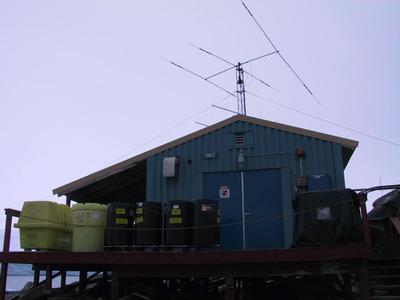
Various petroleum products and different kinds of batteries are sorted and stored here.

Brittney Baldwin is on the deck of the BioLab building. The box contains waste material that will go out on the LM Gould.
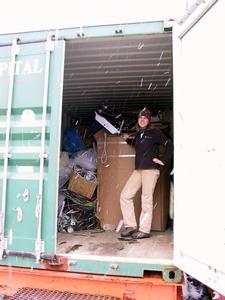
Brittney is inside one of the trash vans to give you an idea of its size. This photo was taken on that same snowy summer day!

Here are some of the barrels for the various types of batteries.
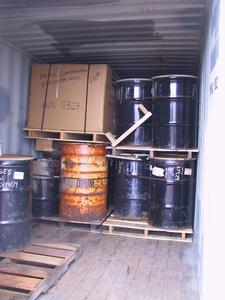
Inside a hazardous waste milvan.

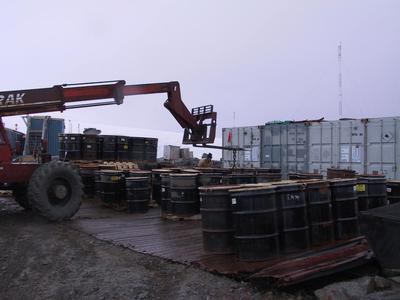
Doug Fink uses the Skytrak to move the barrels into the vans of hazardous waste.

Doug Fink is working at the trash platform (formerly the helicopter landing pad).
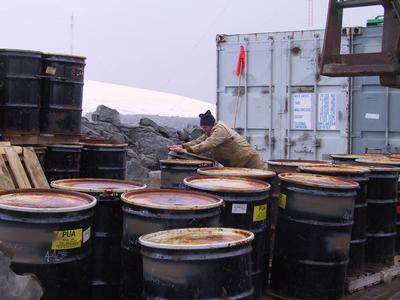
Doug moves the barrels into a manageable set-up on the waste platform.
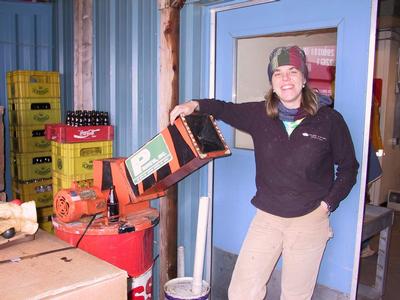
Brittney Baldwin by the bottle grinder. The bottles that are not recyclable are ground up in this machine, stored in barrels, and returned to Chile on the LM Gould.
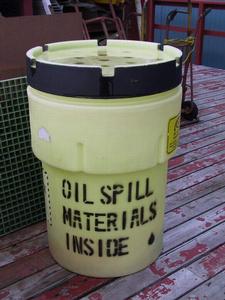
Doug Fink is the Spill Response Team Leader. Any spill on the ground or released into the environment must be dealt with quickly. If ever there is an oil spill, no matter how small,the team evaluates the scene, decides what can be safely done, and isolates the problem and cleans it up. Barrels like this one are available around Palmer Station.
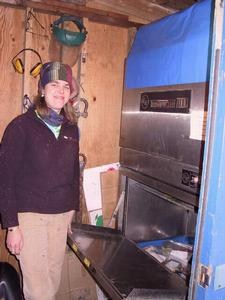
Brittney in the trash compactor room. Solid waste is compacted in this room. Then it is placed in milvans for return to the mainland.
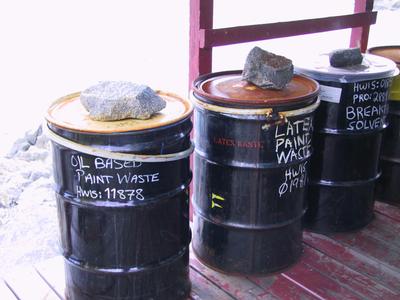
Some waste barrels.
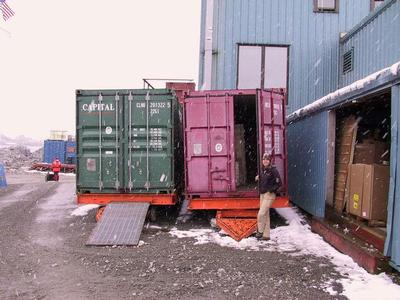
These are the two trash milvans. The deck to the right of the photo is the place where the trash is processed. You can tell that we took this photo during a "summer" snowstorm!
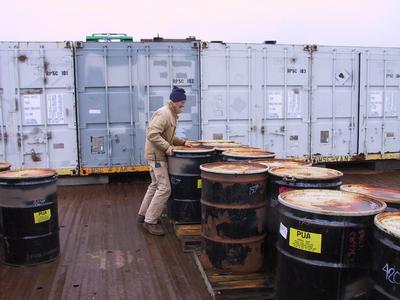
Doug is arranging the barrels in the area where the waste is stored.

This is the shed of the Haz Mat building. Materials are sorted and stored in the appropriate drums..
Contact the TEA in the field at
.
If you cannot connect through your browser, copy the
TEA's e-mail address in the "To:" line of
your favorite e-mail package.
|
